Recessed lighting fixtures are light fixtures that are installed in the ceiling to provide task, accent, ambient, and wall washing lighting effects. They aren't as decorative or expensive as chandeliers or pendants, and aren't quite as complex as track lighting. However, recessed lighting can still be a difficult topic, as it requires knowledge of how your house was built. Del Mar Designs can help you pick the right recessed fixtures for your room.
The Parts of Recessed Downlighting
Unlike other fixtures, recessed lighting requires you to buy multiple pieces and put them together to make the finished product. Juno recessed lighting offers many different options to choose from, such as high end Aculux recessed lights or the standard Juno recessed lighting fixtures. The different components of recessed light fixtures are:
Housing or Can (technically known as a "rough-in"). It includes:
The housing itself
A mounting frame to hold the fixture
Mounting bars that extend to the wood frame
Trim (technically known as a "finishing"). It includes:
The trim itself
A trim ring
Optics (includes reflectors, baffles, diffusers, eyeballs, lenses, and finish insets)
A light bulb (technically called a "lamp", not to be confused with a table lamp).
Below is a guide to help you pick the right pieces to your new recessed downlighting fixture.
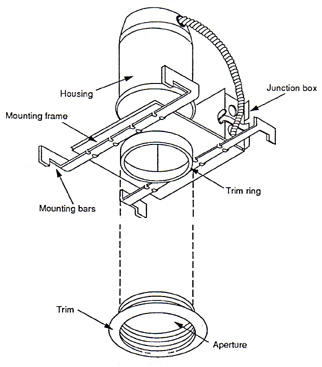
Above: the anatomy of recessed lighting
Housing Size
You need to know how big of a can lighting housing can fit in your ceiling. Inside the ceiling are pieces of wood or steel known as joists, the can lighting will mount between these. They are comparable to studs in the wall, except they are laid horizonatally.
The height distance between your ceiling and the roof interior or the upper floor that sits between these joists is called the plenum. The depth of this plenum determines the size of the housing or can that you can put in there.
Standard joists are either 2x8, 2x10, or 2x12. The actual depth of the beams is 3/8" less than expected, which is 7 5/8", 9 5/8" or 11 5/8".
The total available depth for you is the height of the joist plus the thickness of the ceiling (between 1/2" and 5/8").
Most residential downlights top out at 7 1/2" deep, meaning they will generally fit.
There are shallow recessed housings available if you don't have this much room. Most shallow recessed lighting fixtures are only 5" deep or less.
There are deep housings available if you have extra room. The benefit to deep housings is that they have less glare, but will not fit in 2x8 construction.
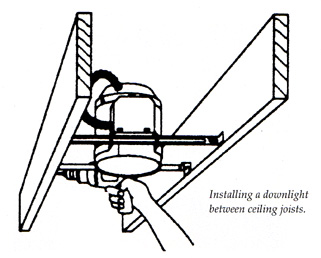
IC Rated vs. NON-IC Rated Fixtures
To know if you need IC or NON-IC rated recessed downlighting, you need to know if the recessed downlight will be installed in an insulated ceiling.
Recessed downlights that are installed in an insulated ceiling must be able to withstand the heat build up the insulation causes and be UL listed specifically for this type of application. These recessed fixtures are called IC Rated.
The drawback to IC Rated Recessed Lights is that the light source is located closer to the trim (increasing the glare). The manufacturer limits the wattage that can be used in ic rated recessed lighting fixtures.
Non-IC Rated Recessed Light Fixtures are generally prefered if your ceiling is not insulated.
Some downlights are listed for both IC and Non-IC use, but with different wattages or bulbs.
Some manufacturers offer a standard and premium IC line: the premium line may offer more options at the drawback of requiring more plenum room.
Note: if you live in Florida, you must use IC-Rated New Construction Housings and IC-Rated Remodel Housings.
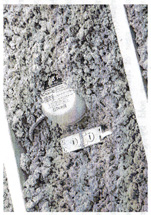
Above: Insulated ceiling
Sloped Ceilings
There are special considerations if you are installed recessed downlighting on a sloped or cathedral ceiling.
Fixtures installed on a sloped ceiling should use a special sloped ceiling recessed lighting housing so that the beam of light shines straight down.
The housing is longer on one side to fit the slope, resembles a flour scoop, and is sometimes called a "shovel cut" can.
To choose sloped ceiling recessed lighting, you need to know the slope or pitch of the ceiling, use our slope finder to get that number.
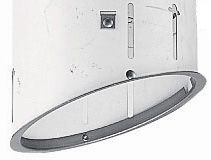
Above: Shovel cut can
New Construction or Remodel?
The process for installing a fixture is different, depending on if you install the fixture during construction or after.
To install a New Construction Can, follow these steps:
You nail the housing in place with hanger bars.
Then the fixture is wired with the junction box.
The trim is completed during the finishing phase.
For existing Remodel Cans, follow these steps:
You cut a hole in the ceiling, then pull out the wires to wire the fixture.
Then, push it back into the ceiling and secure it with clips.
Finally, you attach the trim. Hanger bars are not included with remodel cans.
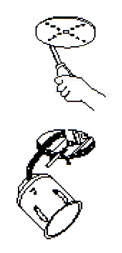
Above: Remodel install
What lighting effect do you want?
What you want to accomplish with your recessed downlights will help us determine the best fixture for you.
Ambient Lighting: Ambient lighting provides overall general light for work, play, socializing, security and everyday tasks. These recessed downlights should produce a wide beam of light on lower ceilings. A narrow beam of light does a better job of delivering light if on a high ceiling. The most appropriate trims:
Standard Open Trims
Premium Baffles
Premium Deep Baffles
Standard Baffles
WETlites
Task Lighting: Downlighting can provide effective task lighting in kitchens, bathrooms, offices, over and peninsulas and utility work spaces. Outdoor recessed lighting fixtures use a special sealed trim. Use the correct outdoor recessed lighting trim to avoid water damage when installing next to wet or damp areas. Try to avoid creating shadows with fixture placement. 3 inch recessed lighting is the most standard for task lighting applications. With an aperture size of 3" on the 3 recessed lighting a light beam can be concentrated in one area. The most appropriate trims: :
Standard Open Trims
Premium Baffles
Premium Deep Baffles
Standard Baffles
WETlites
Accent Lighting: Recessed lighting fixtures can be an effective way to high light artwork, pictures, sculptures or prominent architecture. Recessed lighting fixtures trims most appropriate for accent lighting are:
Premium Open Eyeball
Premium Baffle Eyeball
Premium Adjustable Cone
Premium Adjustable Baffle
Premium Pinhole
If you want a 30° aiming angle for your light and are unsure how far away to place the light, use this formula:
D = Depth (distance from wall to center of luminaire)
H = Height (distance from ceiling to aiming point,)
(Typically aim 1/3 down from the top of the object)
D = H x .5774
Example: Aiming point is 4.5' from the ceiling, D = 4.5 x .5774 = 2.6'
Wall Washing: Wall washing and grazing make a room feel larger by lighting vertical surfaces or walls. Wall washing is done properly by spreading light out evenly over the surface using a special wall wash trim. The most appropriate trims:
Premium Eyelid Wallwash
Premium Eyelid Wallwash w/Baffle
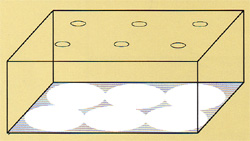
Above: Ambient recessed lighting
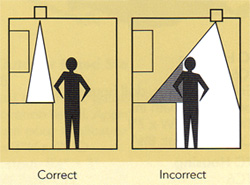
Above: Task recessed lighting
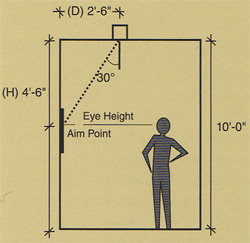
Above: Accent recessed lighting
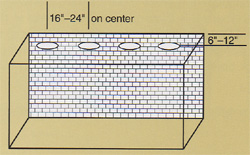
Above: Wall washing





